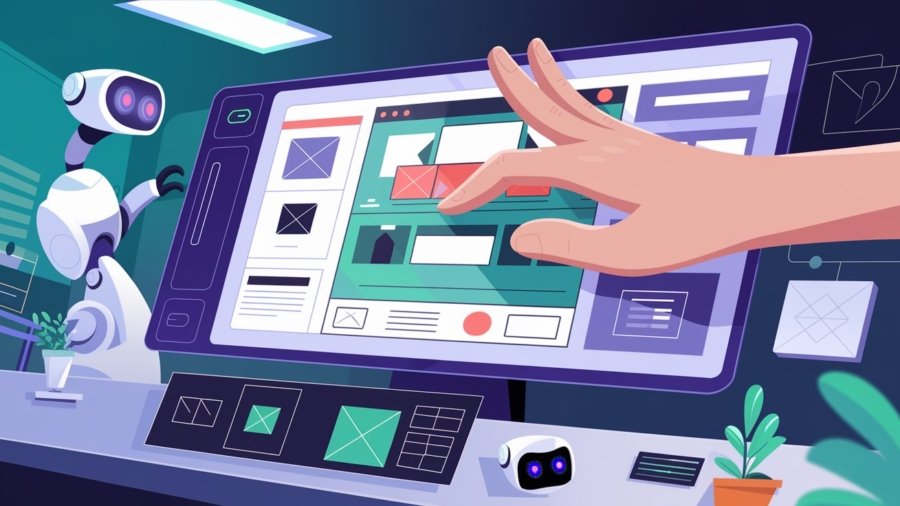The year 2025 marks a transformative era in web development, where no-code platforms, artificial intelligence (AI), and hyperautomation are no longer futuristic concepts but essential tools reshaping how we build, deploy, and interact with digital solutions. These technologies are democratizing innovation, accelerating workflows, and enabling businesses to stay competitive in a fast-evolving digital economy.
In this comprehensive guide, we’ll explore the key trends driving the future of web development in 2025, their real-world applications, and the challenges they bring.
1. No-Code Development: Empowering the Non-Technical Majority
Democratizing Innovation
No-code platforms have evolved from simple drag-and-drop tools to robust ecosystems capable of building complex, enterprise-grade applications. In 2025, these platforms are defined by:
- AI Integration: Tools like Bubble and Webflow now leverage AI to automate workflows, generate code from natural language commands, and predict user needs. For example, users can type “Build a login page with social media integration,” and the platform assembles the components in real time.
- Industry-Specific Solutions: Platforms like Adalo and Glide offer tailored templates for healthcare, finance, and education, enabling compliant apps for telemedicine, patient management, and adaptive learning systems.
- Hybrid Low-Code/No-Code Models: Enterprises are adopting hybrid approaches that combine no-code simplicity with low-code flexibility for advanced customization, accelerating the development of internal tools like HR portals and CRMs.
Real-World Example:
A nonprofit organization used Glide to create a mobile app for coordinating disaster relief efforts. Without writing a single line of code, they integrated real-time data maps, volunteer sign-ups, and donation portals—launching the app in under two weeks during a crisis.
Challenges:
- Scalability: No-code platforms often struggle with high-complexity tasks like real-time multiplayer gaming or advanced machine learning models.
- Security Risks: Pre-built templates may contain vulnerabilities, necessitating robust compliance with regulations like GDPR and HIPAA.
2. AI-Powered Development: From Code Generation to Autonomous Agents
Revolutionizing the Developer Workflow
AI is no longer a supplementary tool—it’s the backbone of modern development. In 2025, AI-driven tools are transforming every stage of the development lifecycle:
- Intelligent Coding Assistants: Tools like GitHub Copilot and Amazon CodeWhisperer reduce coding time by 40%, offering real-time code suggestions, debugging, and even writing entire functions.
- AI Agents: Autonomous agents handle tasks like IT troubleshooting, customer support, and workflow optimization. Microsoft’s Copilot Studio enables non-technical users to build agents, streamlining processes like inventory management and sales forecasting.
- Reasoning AI: Advanced models like OpenAI’s o3 and Google’s Gemini 2.0 Flash Thinking use step-by-step problem-solving to tackle complex tasks, such as generating code for logistics optimization or resolving errors in real time.
Personalization at Scale:
AI’s ability to analyze user data in real-time enables hyper-personalized experiences:
- Dynamic Interfaces: Websites adapt layouts and content based on individual preferences. For example, Netflix-style recommendation engines are now accessible to small businesses via AI tools.
- Chatbots & Voice Assistants: AI-driven chatbots handle 60–70% of customer queries, reducing response times and boosting satisfaction.
Ethical Considerations:
- Bias Mitigation: Tools like IBM’s AI Fairness 360 help developers audit algorithms for fairness.
- Transparency: Regulations like the EU AI Act mandate transparency in AI decision-making, requiring businesses to explain how algorithms arrive at conclusions.
3. Hyperautomation and Serverless Architecture
Streamlining Development Processes
Automation is now end-to-end, merging AI, robotic process automation (RPA), and cloud infrastructure:
- Serverless Dominance: Platforms like AWS Lambda and Google Cloud Functions eliminate server management, reducing costs by 70% and enabling automatic scaling for apps with fluctuating traffic (e.g., e-commerce during peak seasons).
- CI/CD Pipelines: Automated testing and deployment tools like Jenkins and CircleCI cut time-to-market by 30–40%, while AI-powered testing platforms like Testim.io identify bugs across devices and browsers.
- Workflow Automation: Tools like Zapier and UiPath connect apps to automate tasks like syncing CRM data with email campaigns, saving enterprises over 20,000 hours annually.
Impact:
- Healthcare: Hospitals use automation to synchronize patient records across systems, reducing administrative errors.
- Retail: Automated inventory management systems predict stock shortages and reorder products autonomously.
4. The Synergy of No-Code, AI, and Automation
The convergence of these technologies unlocks unprecedented efficiency:
- AI-Augmented No-Code: Platforms like Webflow use AI to generate responsive layouts based on user prompts (e.g., “minimalist landing page with dark theme”) and automate backend processes.
- Voice-Activated Development: Emerging tools allow users to “speak” applications into existence, with AI translating voice commands into functional code.
- Edge Computing: Processing data closer to the source reduces latency for AI-driven apps, enabling real-time analytics in IoT devices and autonomous systems.
Real-World Example:
A travel startup combined Bubble (no-code), GPT-4 (AI content generation), and Zapier (automation) to build a personalized trip-planning app. The AI curates itineraries based on user preferences, while automation handles booking confirmations and payment processing.
5. Challenges and Future Predictions
Key Challenges in 2025
- Security Risks: No-code platforms must adopt SOC 2 compliance and zero-trust architecture to protect sensitive data.
- Ethical AI: Regulations like the EU AI Act mandate transparency in AI decision-making, requiring businesses to audit algorithms for fairness.
- Scalability Limits: Hybrid solutions (no-code + traditional coding) bridge gaps for high-frequency trading or 3D modeling applications.
Predictions Beyond 2025
- AI-First Development: By 2026, AI will handle 50% of coding tasks, from debugging to API integrations.
- Generative Virtual Worlds: AI models like Genie 2 will create interactive 3D environments for gaming, robotics training, and virtual collaboration.
- Sustainable AI: Green coding practices and energy-efficient algorithms will dominate, driven by tools like Microsoft’s carbon-negative data centers.
Conclusion
In 2025, web development is defined by accessibility, intelligence, and speed. No-code platforms empower citizen developers, AI transforms workflows into autonomous processes, and automation eradicates inefficiencies. However, success hinges on balancing innovation with ethical governance and security. Businesses that adopt these trends will lead in a digital-first economy, where ideas turn into impact faster than ever before.
Keywords: No-code AI platforms, AI agents 2025, hyperautomation trends, serverless architecture, ethical AI, sustainable web development, voice-activated development, edge computing.
